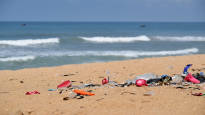Less plastic waste ends up in the sea than previously estimated. But its number is still increasing. According to the UN, more than a million seabirds and about 100,000 marine mammals die every year because of plastic waste.
Plastic that has broken down into small pieces can be found in every corner of the globe, such as in the depths of the oceans.
The amount of plastic waste in the world’s oceans is difficult to estimate and recent Nature Geoscience – the study published in the magazine changes the estimates about it.
Scientists estimate that about 500,000 tons of plastic end up in the oceans every year, and about half of that comes from land. The other half comes from the fishing industry in the form of plastic nets, ropes, buoys and other equipment.
Previously, it was estimated that eight million tons of plastic enters the sea in the rivers alone every year.
It was previously estimated that around 250 thousand tons of plastic waste drifted on the surface of the seas. According to a new study, the amount of surface litter is more than three million tons.
More than 95 percent of the plastic waste in the oceans is larger than 2.5 centimeters. The proportion of microplastics, i.e. garbage less than five millimeters in size, is comparatively small, the research shows.
Collecting floating and larger plastic debris from the sea is clearly easier than microplastics.
The researchers found that the amount of plastic is at least not decreasing. According to the study, the amount of plastic in the ocean continues to increase by about 4 percent every year. Thus, the amount of plastic on the sea surface can even double in 20 years, says the study The New York Times.
Unpleasant effects on animals and humans
Plastic pollution in the seas harms marine wildlife and at the same time also harms people.
Up to five grams of microplastics end up in the human body per week, according to the global report published by the WWF in 2019 from the report.
Microplastics accumulate in the human body from food, such as fish and seafood, as well as from bottled and tap water.
Five grams equals the weight of one bank card. About 21 grams of microplastic ends up in the body of a single person every month, and up to 250 grams in a year.
According to the UN, more than a million seabirds and an estimated 100,000 marine mammals die every year because of plastic waste.
Wild animals become entangled in nets, ropes and plastic packaging left in the wild, The New York Times reports. Many animals also get sick or injured after swallowing plastic. Some die of starvation after the digestive system is blocked.
At the beginning of August, it was reported that the collection of plastic fishing gear is becoming mandatory in Finland. However, the final method of collecting plastic fishing gear has not yet been decided.
Even if plastic waste doesn’t end up in the sea, it still pollutes beaches, rivers, lakes and land.
Source: STT-AFP
What thoughts does the article evoke? You can discuss the topic until Wednesday at 11 p.m.
